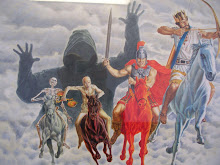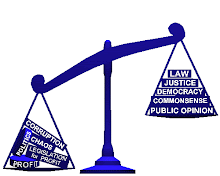CELL PHONES and other size challenged devices, link here for links to all TOPICS on this site
Related Link:
Did you ever wonder WHY Jesus descended into hell for 3 days? Link here to view topic
Then scroll down to
4. JESUS DESCENDS into the GRAVE/SHEOL/HADES to speak to the UNGODLY and to RESCUE the GODLY
Jesus Died on Wednesday 3 PM and Rose on Saturday 3PM
Then certain of the scribes and of the Pharisees answered, saying, Master, we would see a sign from thee.
But he answered and said unto them, An evil and adulterous generation seeketh after a sign; and there shall no sign be given to it, but the sign of the prophet Jonas: For as Jonas was three days and three nights in the whale's belly; so shall the Son of man be three days and three nights in the heart of the earth. - Matthew 12: 38-40
Jesus Christ plainly said He would be entombed for three days and three nights. Can this be reconciled with a "Good Friday" crucifixion and burial and an "Easter Sunday" resurrection, which allows for barely a day and a half in the tomb? Or do the Gospels spell out a surprising, simpler solution that fits perfectly with what Jesus foretold?
In Matthew 12:38, some of the scribes and Pharisees asked Jesus for a sign to prove He was the Messiah. "Teacher, we want to see a miraculous sign from you," they told Him (New International Version).
But Jesus responded that the only sign He would give was that of the prophet Jonah: "For as Jonah was three days and three nights in the belly of a huge fish, so the Son of Man will be three days and three nights in the heart of the earth" (Matthew 12: 40).
Traditional view doesn't fit
But how can we fit "three days and three nights" between a Friday afternoon crucifixion and entombment just before sundown and a Sunday morning resurrection at sunrise? This traditional view allows for Jesus to have been in the tomb for only a day and a half.
Some believe that Christ's statement that He would be "three days and three nights in the heart of the earth" does not require a literal span of 72 hours. They reason that any part of a day can be reckoned as a whole day.
Thus, since Jesus died in the afternoon and was entombed just before sunset, they think the closing few minutes of that Friday constituted the first day, Friday night was the first night, Saturday was the second day, Saturday night was the second night, and a few minutes at dawn on Sunday morning made up the third day.
But where, then, is the third night? Even if a few minutes of daylight late on Friday and another few on Sunday morning constitute "days," this interpretation fails to explain how only two nights—Friday night and Saturday night—can somehow be the three nights of which Jesus spoke.
In fact, Scripture is plain that Jesus had already risen before Mary Magdalene came to the tomb early Sunday morning, arriving "while it was still dark" (John 20:1-2 )
[1] The first day of the week cometh Mary Magdalene early, when it was yet dark, unto the sepulchre, and seeth the stone taken away from the sepulchre.So in reality, no parts of Sunday could be counted as a day, as Jesus was already resurrected well before the break of dawn.
[2] Then she runneth, and cometh to Simon Peter, and to the other disciple, whom Jesus loved, and saith unto them, They have taken away the LORD out of the sepulchre, and we know not where they have laid him.
Jonah 1:17 to which Jesus referred, states specifically that "Jonah was in the belly of the fish three days and three nights." We have no biblical basis for thinking that Jesus meant only two nights and one day, plus part of another day. If Jesus were in the tomb only from late Friday afternoon to early Sunday morning, then the sign He gave that He was the prophesied Messiah was not fulfilled.
So which is it? Is something wrong with Christ's words, or is something wrong with the traditional view of when and how long He was in the tomb?
Let's carefully examine the details from the Gospels. When we do, we uncover the real story of how Jesus' words were fulfilled precisely.
Double click on chart for clear enlargement
The Hour of Jesus'Death
In the time of Jesus, the Jewish 24 hour day was divided into 2 blocks. It began with the night hours that began at 6pm (sunset) and ended at 6am (sunrise) and was followed by the daytime hours that began at 6am and ended at 6pm. The Bible tells us that Jesus died at 3 pm.
Matthew 27: 45-46, 50
45 Now from the sixth hour [12 noon] there was darkness over all the land unto the ninth hour.Two Sabbaths mentioned
46 And about the ninth hour [3 pm] Jesus cried with a loud voice, saying, Eli, Eli, lama sabachthani? that is to say, My God, my God, why hast thou forsaken me? . . . 50 Jesus, when he had cried again with a loud voice, yielded up the ghost.
Notice the sequence of events outlined in Luke 23. Jesus' moment of death, as well as His hasty burial because of the oncoming Sabbath that began at sundown, is narrated in verses 46-53. Verse 54 then states, "That day was the Preparation, and the Sabbath drew near."
In Jewish society of that time, heavy cooking and housecleaning were done on the day before a Sabbath in preparation for it. Thus the day before the Sabbath came to be called "the preparation day" or simply "the preparation." The biblical weekly Sabbath falls on Saturday, the seventh day of the week. According to Bible reckoning, days begin at sunset , so all weekly Sabbaths start Friday evening at sundown.
(Leviticus 23:32 )
It shall be unto you a sabbath of rest, and ye shall afflict your souls: in the ninth day of the month at even [evening], from even [evening] unto even [evening], shall ye celebrate your sabbath.Compare Genesis 1:5
And God called the light Day, and the darkness he called Night. And the evening and the morning were the first day.Based on these facts, many people have assumed wrongly that it is the weekly Sabbath mentioned here, and that Jesus was therefore crucified on a Friday.
But two types of "Sabbaths" are mentioned in the Scriptures—the regular weekly Sabbath day, which fell on the seventh day of the week, and seven annual Holy Days (listed in Leviticus 23), High Sabbaths that could—and usually did—fall on days of the week other than the regular weekly Sabbath day.
Was the day after Jesus was crucified a weekly Sabbath, or one of these annual Holy Days? John 19:31 clearly states that this approaching Sabbath "was a high day."
The Jews therefore, because it was the preparation, that the bodies should not remain upon the cross on the sabbath day, (for that sabbath day was an high day,) besought Pilate that their legs might be broken, and that they might be taken away.This term does not refer to the weekly Sabbath (Friday sunset to Saturday sunset), but in this context to the first day of Unleavened Bread, one of God's annual Holy Days, a High Sabbath (Exodus 12:16-17 )
[16] And in the first day there shall be an holy convocation, and in the seventh day there shall be an holy convocation to you; no manner of work shall be done in them, save that which every man must eat, that only may be done of you.See also Leviticus 23:6-7
[17] And ye shall observe the feast of unleavened bread; for in this selfsame day have I brought your armies out of the land of Egypt: therefore shall ye observe this day in your generations by an ordinance for ever.
[6] And on the fifteenth day of the same month is the feast of unleavened bread unto the LORD: seven days ye must eat unleavened bread.A number of Bible commentaries, encyclopedias and dictionaries will confirm that John is not referring to the weekly Sabbath here, but rather to one of the annual Sabbaths.
[7] In the first day ye shall have an holy convocation: ye shall do no servile work therein.
According to the biblical calendar, in that year this high-day Sabbath fell on a Thursday (meaning it began on, what we would consider, Wednesday night at sunset). We can confirm this by looking at the details in the Gospel accounts—which show us that two separate Sabbath days are mentioned. Luke 23:55-56 tells us that the women, after seeing Christ's body being laid in the tomb just before sundown, "returned and prepared spices and fragrant oils" for the final preparation of the body.
[55] And the women also, which came with him from Galilee, followed after, and beheld the sepulchre, and how his body was laid.They would not have done such work on a Sabbath day, weekly or annual, since it would have been considered a Sabbath violation. This is verified by Mark's account, Mark 16:1 , which states:
[56] And they returned, and prepared spices and ointments; and rested the sabbath day according to the commandment.
"Now when the Sabbath was past, Mary Magdalene, Mary the mother of James, and Salome bought spices [which they could not have purchased on a Sabbath day], that they might come and anoint Him"The women had to wait until this High Sabbath [from Wednesday sunset to Thurday sunset] was over before they could buy and prepare the spices to be used for anointing Jesus' body. Then, Luke 23:56 tells us that, after purchasing and preparing the spices and oils on Friday [from Thursday sunset to Friday sunset], "they rested on the [weekly]Sabbath according to the commandment" —which means they had to have acquired the spices before that Sabbath on which they rested. This second Sabbath mentioned in the Gospel accounts is the regular weekly Sabbath, observed from Friday sunset to Saturday sunset.
By comparing details in both Gospels —where Mark tells us the women bought spices after the Sabbath and Luke relates that they prepared the spices before resting on the Sabbath—we can clearly see that two different Sabbaths are being discussed here.
The first Sabbath, as John 19:31 tells us, was a "high day" —the first day of the Feast of Unleavened Bread—which, in A.D. 31, fell on a Thursday. [from Wednesday sunset to Thursday sunset]
The Jews therefore, because it was the preparation, that the bodies should not remain upon the cross on the sabbath day, (for that sabbath day was an high day,) besought Pilate that their legs might be broken, and that they might be taken away.The second Sabbath was the weekly seventh-day Sabbath. (To see these events spelled out day by day, see the chart.)
Sign of the Messiah
After the women rested on the regular weekly Sabbath, they went to Jesus' tomb early on the first day of the week (Sunday), "while it was still dark" and found that Jesus had already been resurrected. Jesus was not resurrected at sunrise on Sunday morning.
When Mary Magdalene arrived "while it was still dark" she found the stone rolled away and the tomb already empty!
(John 20:1)
The first day of the week cometh Mary Magdalene early, when it was yet dark, unto the sepulchre, and seeth the stone taken away from the sepulchre.(Matthew 28:1-6 )
[1] In the end of the sabbath, as it began to dawn toward the first day of the week, came Mary Magdalene and the other Mary to see the sepulchre.(Mark 16:2-6)
[2] And, behold, there was a great earthquake: for the angel of the Lord descended from heaven, and came and rolled back the stone from the door, and sat upon it.
[3] His countenance was like lightning, and his raiment white as snow:
[4] And for fear of him the keepers did shake, and became as dead men.
[5] And the angel answered and said unto the women, Fear not ye: for I know that ye seek Jesus, which was crucified.
[6] He is not here: for he is risen, as he said. Come, see the place where the Lord lay.
[2] And very early in the morning the first day of the week, they came unto the sepulchre at the rising of the sun.(Luke 24:1-3)
[3] And they said among themselves, Who shall roll us away the stone from the door of the sepulchre?
[4] And when they looked, they saw that the stone was rolled away: for it was very great.
[5] And entering into the sepulchre, they saw a young man sitting on the right side, clothed in a long white garment; and they were affrighted.
[6] And he saith unto them, Be not affrighted: Ye seek Jesus of Nazareth, which was crucified: he is risen; he is not here: behold the place where they laid him.
[1] Now upon the first day of the week, very early in the morning, they came unto the sepulchre, bringing the spices which they had prepared, and certain others with them.When we consider the details in all four Gospel accounts, the picture is clear. Jesus died at 3 pm and was entombed late Wednesday afternoon, just before a Sabbath began at sunset. However, that was a high-day Sabbath, lasting from Wednesday sunset to Thursday sunset that week, rather than the regular weekly Sabbath that lasted from Friday sunset to Saturday sunset.
[2] And they found the stone rolled away from the sepulchre.
[3] And they entered in, and found not the body of the Lord Jesus.
Since Jesus died at 3 in the afternoon, according to His own words He would have been resurrected at around the same time three days and nights (72 hours) later. He remained in the tomb from Wednesday at sunset until Saturday at 3 pm, when He rose from the dead. While no one witnessed His resurrection (which took place inside a sealed tomb), to fit His words and the biblical evidence it had to have happened three days and three nights later, at 3 pm on Saturday.
This time line perfectly accommodates three full Jewish nights - 6pm to 6am (Wednesday, Thursday and Friday - a total of 36 night hours) and three full Jewish daylight periods (Wednesday 3pm to 6pm, Thursday 6am to 6 pm, Friday 6am to 6 pm and Saturday 6am to 3pm - a total of 36 day hours) . This is the only time that fits Jesus' own prophecy of how long He would be in the tomb. And, as we have seen, it fits perfectly with all the details recorded in the Gospels and the sign of Jonah spoken of by Jesus.
We can be assured that the entombment period Jesus gave as proof He was the Messiah was exactly the duration He foretold. Because most people do not understand the biblical Holy Days Jesus Christ and His followers kept, they fail to understand the chronological details so accurately preserved for us in the Gospels.
















